The Armenians in the Turkish Empire
The Ottoman Empire, in addition to the Turks, included several minorities. Among them were Kurds, Greeks, Jews and Armenians. Most of the businesses such as shipping, banking and manufacturing were in the hands of the Greek, Jewish and Armenian minorities.
The Armenians over the centuries had been good citizens of the sultans. One of the nineteenth century sultans even declared the Armenians his "most loyal millet" (A millet is a national or religious group with in the Ottoman Empire).
However, the Moslems looked upon the non-Moslem groups as "cattle" or "gaiour". Non-Muslims were not granted the liberties and political rights of the believers. They were in fact second-class citizens.
Because of the relegious and financial situation, there was a level of animosity towards the non-Turkish minorities.
Massacre of Armenians in 1895
There were numerous massacres in 1895 in which an estimate 100,000 to 200,000 Armenians lost their lives. These including:
- A massacre in Constantinople from September 30 to October 6 calmed by the efforts of European ambassadors.
- A massacre in Harpoot from November 10 to November 11 in which over 500 people were killed.
- A massacre in Sivas on November 12 in which approximately 1,500 people were killed.
-
A massacre of Armenians in Akhisar on October 15, 1895 in which 35 people lost their lives.
The Reverent Mr. Chambers of the American mission sent the following report to London on October 22, 1895.
"As I enterd the village of Akhisar on Sunday, a fearful stench greeted me. Several bodies that had that morning been removed from a well were being buried. I visited four wells, from one of them-- ten minutes walk from the scene of the slaughter--- fourteen bodies had been recoveerd, from another, two, from another, five. One had not yet been opened; there were bloodmarks on the stones covering it. In all, twenty three bodies have been recovered for burial....
The murders were committed in the most inhuman manner: cudgels, knives, axes, swords, and firearems were used. Young boys helped in the slaying. Ropes were tied to the feet of the dead and the bodies were dragged through the streets.... and thrown in the wells. One old man of 75 years was tumbled in without being killed, and was left to die among the corpses of his friends.
There were almost 200 Armenian shops..... I was amazed to see what a clean sweep was made. The merchants' money, watches and other valuables were first secured, then the men killed and their account books, notes of hand and valuable papers, torn to shreds.
There were sizteen armed officials present.... but their presence was evidently and encouragement to the killers. They could have stopped the slaughter at its inception or at any time during its course....Instead of attempting to do so they acted as follows: Kolaghassi (a police officer) observed the killing for forty minutes and then taking with him three zaptiehs (police officers of another rank) rode to Gueve, five miles away, to give word to the Kaimakam (the commissioner of a subdistict) who four hours after the slaughter commenced, arrived on the scene. This shows fiendisth deliberation of movement.....
The killing of so many, the disposing of the bodies, the careful covering up of the wells, the washing of the bloodstains... all show a perfection of plan and deliberation of action impossible to an unprepared and suddenly aroused mob..... There had never been the slightest trace of Hunchagism (Armenian political activity) in Akhisar, the Armenians had no arms and made no resistance, not did they do anything to bring on the affray."
In order to draw attention to the situation of the Armenians in Anatolia, on August 26, 1896 a group of twenty five Armenians seized control of the Ottoman Bank in Constantinople. They treatened to blow up the bank unless their greivances were addressed. They received save conduct to a French ship in the harbor. After their departure there was a massacre of Armenians in the Galata commercial quarter. The attacks which included widespread looting lasted two days and eventually spread to the Armenia section of the Jewish quarter. The Armenian population of both these quarters was almost completely wiped out. It is estimated that five to six thousand Armenians were killed. The carnage was finally stopped when British troops moved in obstenibly to protect British lives and property. Many Armenians in the city emigrated within a few months of this incident.
Abraham and Lucy were married in the Beyoghle section of Constantinople in 1895. Their daughter, Catherine was baptized in October 1896 in the same church as the marriage but the address listed was Galatia.
Massacre of Armenians in Adana in Cilicia in 1909
There was an incident in April (13th-16th) 1909 of anti-Armenian demonstrations in Adana in Cilicia. The government in Constantinople sent two divisions of solders to quell the disturbance. On April 24, before the troops arrived, new hostilities broke out. The regular army units in the area, opened fire on the very crowded Armenian quarter, and hurled firebombs into it. About 200 small villages in the area were burned and plundered. The number of Armenia deaths was estimated to be about 30,000. It is not clear whether these atrocities occurred with the sanction of the government or were totally independent of the government.
The 1915 Genocide
It is clear, however, that the Turkish government subsequently developed a well established plan to eliminate the Armenians.
The Armenians in the Turkish army were deprived of the guns in the fall and winter of 1914. They were sent to build roads under the most primitive conditions. The rate of death was very high. Those who did not die were tied together and shot.
In February 1915 in a speech in the closed session of the Central Committee of the Committee of Union and Progress (the party of the Young Turks) the following statement was made
"If we remain satisfied with the sort of local massacres which took place in Adana and elsewhere in 1909... if this purge is not general and final, it will inevitably lead to problems, Therefore, it is absolutely necessary to eliminate the Armenian people in its entirety, so that there is not further Armenian on this earth and the very concept of Armenia is extinguished.Having made the decision to annihilate the Armenians there was the question of how to do it. The answer was fiendishly simple.We are now at war. We shall never have a more suitable opportunity than this. We need pay no attention to protests from the press or fear the intervention of the Powers. And even if we were to pay attention, it will make no difference because it will be an accomplished fact for all time.
This time the action will produce total annihilation and it is essential that no single Armenian survives it. Perhaps ther are those among you who feel it is bestial to go so far. You may ask, for instance, what harm can children, the elderly or the sick do to us that we feel compelled to work for their elimination. Or you may feel that only those guilty should be punished... I beg you gentlemen, don't be weak. Control your feelings of pity. Otherwise these very feelings will bring about our own demise."
First a proclamation was made in each Armenian village that all the able bodied Armenian men had to present themselves to the local government building to be deported . They were assured that the government was benevolent. Opon their arrival the men were locked in jail for a day or two. Then they were let out of jail and marched out of town to the first lonely spot were they were shot or bayoneted to death.
A few days later the old men, women and children were summoned in the same way. Some of the Turks chose the most attractive young women as their "brides", others adopted Armenian children. Apparently this was not entirely malevolent. These Turks, who had lived in close proximity to their Armenian neighbors, may have known what lay ahead for most of the Armenian women and children. In interviews with survivers after the war, some of the women and children who lived with the Turks spoke with great respect for the people who took them in and many said that they had been treated well.
The old men, women and children that remained were robbed of their valuables, and then were forced to march endlessly with little food and water. They were "guided" by Turkish souldiers. However, the Turkish government had released prisoners spicifically for the purpose of allowing them to harrass the caravans of Armenians. The government also encouraged bands of Kurds to attack the caravans. This bands of ex-prisoners and Kurds took what little the Armenians had left and repeatedly raped the remaining women. Thousands of Armenians died from thirst, hunger, exposure or exhaustion. Many were driven south through the Syrian desert to Aleppo. Those who refused to keep moving were whipped and beaten.
Unbelievably, some of these people lived to tell their stories and the Turkish government, to this day, refuses to acknowledge that there was ever a planned policy to exterminte the Armenians.
Other Minorities
Although the Greeks living in Turkey had been there since ancient times they had the country of Greece to look out for their interests to some degree. In 1915 Greece had not entered the war. Turkish concern about Greece entering the war on the side of the Allies forced them to treat the Greeks in Turkey with an eye to world opinion.
None the less, the Greeks were subjected to many of the same cruelties as the Armenians. Greek soldiers were forced to build roads in the Caucasus where many died for cold and hunger. Greek house were searched. Greek women were taken into Turkish harems and Greek boys were "adopted" by Turkish families. Some 200,00 to 1,000,000 Greeks were rounded up and deported to the Greek islands off the coast of Turkey or on forced marches to the interior of Turkey, but they were not treated as horribly as the Armenians who had no homeland to look out for their interests .
Ambassador Morgenthau's Story
Henry Morgenthau was the American ambassador to Constantinople from 1913 to 1916. He wrote Ambassador Margenthau's Story in 1917/18. It is, in my opinion, the best work dealing with the Armenian question currently in print.
The Roundup of Armenians from Sivas and Harput
Morgenthau has the following to say about the Armenians from Harput and Sivas.
"It is absurd for the Turkish Government to assert that it ever seriously intended to "deport the Armenians to new homes"; the treatment which was given the convoys clearly shows that extermination was the real purpose of Enver and Talaat. How many exiled to the south under these revolting conditions ever reached their destinations? The experience of a single caravan show how completely this plan of deportation developed into one of annihilation. The details in question were furnished me directly by the America Consul at Aleppo, and are now on file in the State Department at Washington. One the first of June a convoy of three thousand Armenians, mostly women, girls and children left Harpoot. Following the usual custom the government provided them an escort of seventy gendarmes, under the command of a Turkish leader, a Bey. In accordance with the common experience these gendarmes proved to be not their protectors, but their tormentors and their executioners. Hardly had they got well started on the road when ____Bey took 400 liras from the caravan, on the plea that he was keeping it save until their arrival at Malatia; no sooner had he robbed them of the only thing that might have provided them with food than he ran away, leaving them all to the tender mercies of the gendarmes.All the way to Ras-ul-Ain, the first station on the Bagdad line, the existence of these wretched travelers was one prolonged horror. The gendarmes went ahead, informing the half-savage tribes of the mountains that several thousand Armenian women and girls were approaching. The Arabs and Kurds began to carry off the girls, the mountaineers fell upon them repeatedly, violating and killing the women, and the gendarmes themselves joined in the orgy. One by one the few men who accompanied the convoy were killed. The women succeeded in secreting money from their persecutors, keeping it in their mouths and hair; with this they would buy horses, only to have them repeatedly stolen by the Kurdish tribesmen. Finally the gendarmes, having robbed and beaten and violated and killed their charges for thirteen days, abandoned them altogether. Two days afterwards the Kurds went through the party and rounded up all the males who were still alive. The found about 150, their ages varying from 15 to 90 years, and these they promptly took away and butchered to the last man. But that same day another convoy from Sivas joined this one from Harpoot, increasing the numbers of the whole caravan to 18,000."
According to Morgenthau this convoy was harrased continuously in the way described above. By the time they reached the Euphrates (at Birjik or Samat?) the Armenians were virtually naked. At the Euphrates they say hundreds of bodies floating in the river. They were forced to continue marching naked in the scorching desert sun. For five days they were not given "a morsel of bread or a drop of water". After five days they reached a well where the police refused to let them drink unless they paid three liras for a cup of water. Out of desperation, many threw themselves to their deaths in the well.
Morgenthau continues.
"On the seventieth day a few creatures reached Aleppo. Out of the combined convoy of 18,000 souls just 150 women and children reached their destination. A few of the rest, the most attractive, were still living as captives of the Kurds and Turks; all the rest were dead"
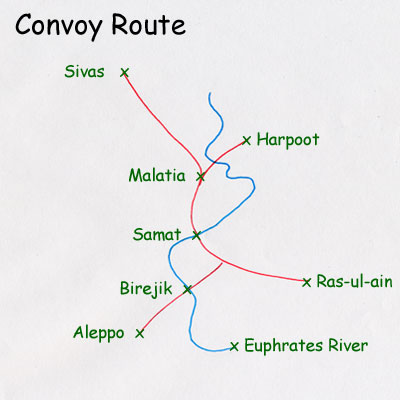 |
My map (based on Hewsen's Atlas) of the "deportation" route with the
places mentioned by
Morgenthau and the two places that the
convoy crossed the Euphrates. According to Hewsen's map Rus-ul-Ain (Rusulayn) appears off the route to Aleppo. From Malitia to Sivas was normaly "a nine hours journey" |
|
America, America America, America directed by Elia Kazan in 1963 is the story of the immigration of his uncle from Anatolia in Turkey to America. Many aspects of this movie deal with the Armenian situation.
The First Genocide Of The 20th Century; The Story of the Armenian Massacres In Text And Pictures The First Genocide Of The 20th Century; The Story of the Armenian Massacres In Text And Pictures compiled by James Nazer starts with an introduction and blessing by two patriarchs of the Armenian Apostolic Church, proceeds to a chapter on the history of Armenia which deals with the great Armenian kings and warriors of the past and is very grandiose. This is followed by a chapter on famous Armenians encluding: doctors, lawyers, writers, composers, actors, singers, etc. complete with publicity pictures. Then one is plunged with no warning into excerpts from a report sent from Viscount Bryce to Viscount Grey of Fallodom, secretary of Foreign Affairs in 1916 about the atrocities of the Armenian Genocide. This report includes "documents" which are like depositions. There is no explanation of who either Viscount Bryce of Viscount Grey are. I would assume that they are English because the report was "laid" before the "House of Parliament" in 1916. With a few exceptions, there is no mention of who gave the depositions in the documents, what nationality they are or what exactly they are doing roaming around Turkey in the middle of World War I. They do seem to be given by Europeans. These documents are unbelievable upsetting in the descriptions of the atrocities that were committed. They are very powerful. There are also some amazing photos of the dead and dying Armenians. What I don't understand about this book is why all the fal-da-rah for the first several chapters to be plummetted into the horrors of the massacres without warning. The excerpts below are taken from the "documents".The excerpts that I selected were not necessarily the most horrific. I chose things that mentioned Sivas. From Document 7
"It is now established that there is not an Armenian left in the province of Erzeroum, Trebizond, Sives, Kharpoud, Bitles, and Dizarbehir. About a million of Armenian inhabitants of these provinces have been deported from their homes and sent southward into exile. The convoys of women and children were placed in front of the Government buildings at each town or village where they passed, to give the Moslems an opportunity of taking their choice.Note: Kharpund is a variation of the spelling of Harpoot. From Document 12 This document contains descriptions of the following atrocities. "Armenians were thrown live down well and into fires. Corpses were floating on the Euphrates. Two to six corpses would be tied together. Male corpses with their genitals removed. Female corpses ripped open. Turkish authorities refused to allow burial of the corpses because they said they did know it the dead were Christiana of Moslem and so did not know which type of burial to give them. Corpses stranded on the banks of the river being devoured by dogs and vultures. Women who gave birth and were forced to abandon the newborn and continue to march on moments after the birth. " From Document 73 "Extracts from an interview with Comm. G. Gorrini, Late Italian Consul-General at Trebizond, Published in the Journel "Il Mesaggero" of Rome 25th August 1915"
" As for the Armenians, they were treated differently in different vilayets. They were suspect and spied upon everywhere, but they suffered a real extermination, worse than massacre, in the so called "Armenian Vileyets". The New York Times March 20, 1915 WHOLE PLAIN STREWN BY ARMENIAN BODIES Turks and Kurds Reported to Have Massacred Men, Women and Children
London: March 19.- Appalling accounts of conditions in Armenia have reached the officials in London of the Armenian Red Cross and have been given out by them. The latest recital is from an Armenian doctor named, Derderian, who says that the whole plain of Alashgerd is virtually covered with the bodies of men, women and children. The New York Times October 1, 1915 TELL OF HORRORS DONE IN ARMENIA Report of Eminent Americans Say They Are Unequaled in a Thousand Years The situation in Turkey was investigated by the Committee on Armenian Atrocities, "a body of eminent Americans" who issued a detailed report about the atrocities committed by the Turks against the Armenians. The Times said in part: "The report tells of children under 15 years of age thrown into the Euphrates to be drowned; of women forced to desert infants in arms and to leave them by the roadside to die; of young women and girls appropriated by the Turks, thrown into harems, attacked, or else sold to the highest bidder, and of men murdered and tortured. Everything that an Armenian possesses, even to the clothes on his back, are stolen by his persecutors. The report days the use of bastinado has been revived, high dignitaries of the church have been hanged, families scattered to the four winds, and thousands upon thousands of defenseless, miserable persons herded together like cattle and driven into the desert lands of the empire, there to starve and die."Excerpts from the report quoted by the time include: "the deportation began some six weeks ago with 180 families from Seitun; since which time all the inhabitants of that place and its neighboring villages have been deported; also most of the Christian in Albustan, many from Hadjin, Sis, Kars, Pazar, Hassan, Byle and Deort Yol. June 20."The report said that different attitudes were taken concerning food and water. In some places the deportees were fed by the Government in other places it permitted the local inhabitants to feed them and yet in other places the deportees were not allowed any food and water. "there has been much hunger, thirst, and sickness, and some real starvation and death."Various forms of torture to men were reported including bastinado a very old and painful torture of beating the bottoms of the feet until they bleed) and searing the chest with hot irons, burning body parts with sulphur, the burning out of eyes. After being tortured the men where chained together and marched out of the towns and murdered. Many of the people who were deported later than other groups reported marching by roadsides filled with courpses.
The New York Times October 9, 1915 SENDS $100,000 TO AID ARMENIAN REFUGEES Monies were to be distributed at Konitza, Afana, Tarsus, and Durfa and through the American council in Aleppo. The amount was described as "pitifully insufficient to meet the terrible need". Many of the Armenian refugees had fled to Russia, Egypt, and Greece. "Many thousands of Armenians are reported to have reached Russia" There was a basic request for additional help in funds.
|
|
National Geographic October 1915 The October 1915 National Geographic contained articles on Greece, Roumania and "Armenia and the Armenians." It mentioned the Armenian "troubles" in 1876, 1878, 1895-96, 1906 but only very briefly refers to the massacres of the spring and summer of 1915. Horrible as have been the Armenian massacres of previous years, they are surpassed by the terrible conditions of 1915. The world has never seen a more furious effort to drive out a people, or more cruel methods in their execution than are now being employed against this unhappy race."As typifies National Geographic there were lots of pictures in the October 1915 issue. The only two pictures that gave any indication of the "troubles" in 1915 are these two. |
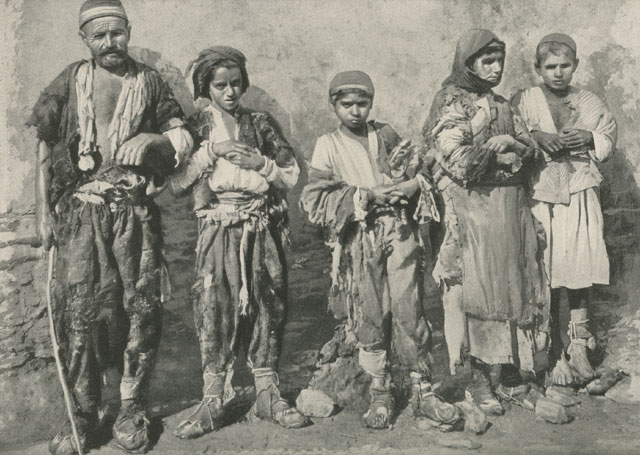 |
| AN ELOQUENT PICTURE OF THE POVERTY IN ARMENIA |
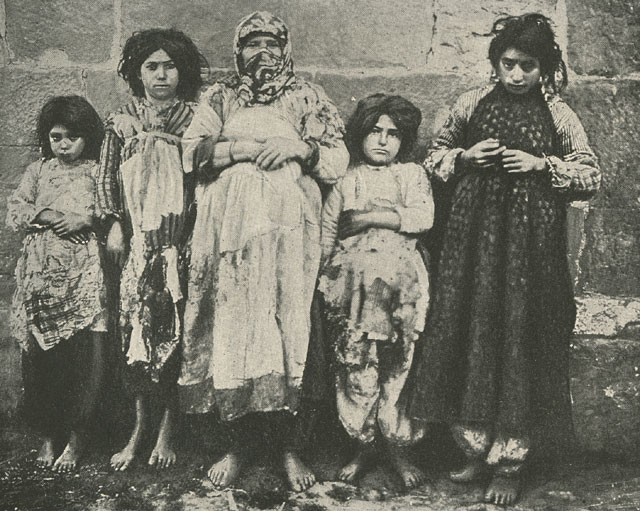 |
| ARMENIANS The captions on the pictures does nothing to shed any light on who these people were, exactly where they were from, and why they were in such a state. All of the other images were cultural in nature. To see the rest of these images go to The Armenians in Turkey
|
| Story of Near East Relief (1915-1930) An Interpretation by James L. Barton, 1930 The Near East Relief committee was formed by a group of prominent Americans in response to Ambassador Morgenthau's reports on the treatment of the Armenians and other minorities in the Ottoman Empire. Barton's book published in 1930 included the following photos of the refugees. Unfortunately only a few of the photos were dated. |
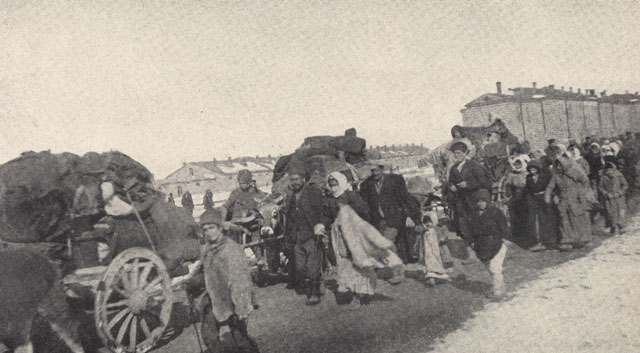 |
| Story of Near East Relief (1915-1930) An Interpretation
by James L. Barton 1930 "Armenian refugees on the march fhrough the city of Alexandropol. Duplicates of this pitiful procession might be found on any road in Anatolia, Cilicia or the Caucasus between 1915 and 1922" |
 |
| Story of Near East Relief (1915-1930) An Interpretation
by James L. Barton 1930 "This group of human wreckage represents tens of thousands when first approached with aid" |
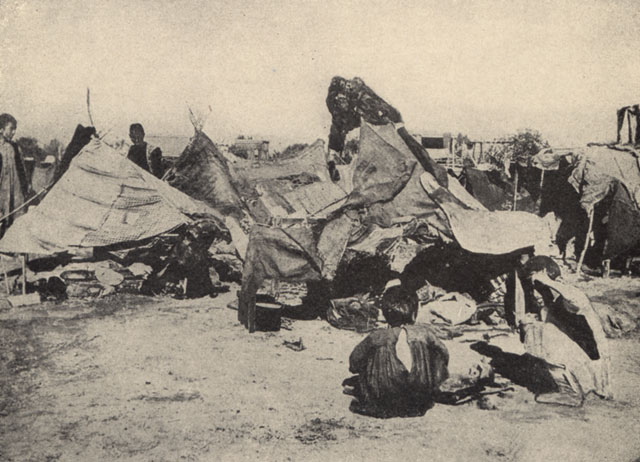 |
| Story of Near East Relief (1915-1930) An Interpretation
by James L. Barton 1930 "Near East childhood on the waysides and in the refugee camps, 1915-1919" |
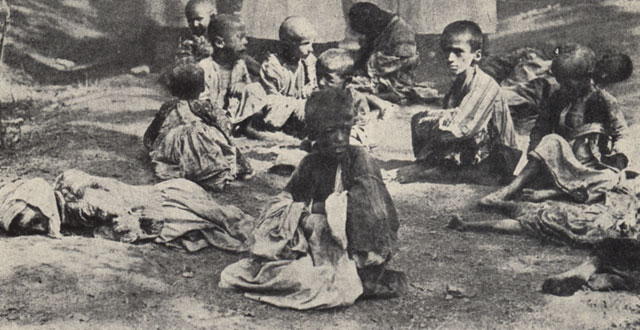 |
| Story of Near East Relief (1915-1930) An Interpretation
by James L. Barton 1930 "Starving, diseased and filthy, these were the children of the Newr East who were gathered into the orphanages in the arly days of the disaster" |
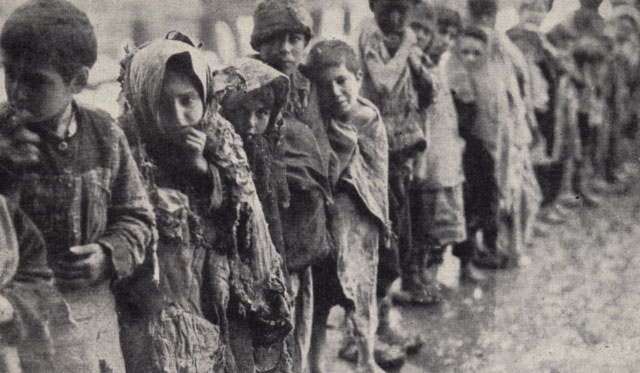 |
| Story of Near East Relief (1915-1930) An Interpretation
by James L. Barton 1930 "Children waiting in the snow for admission into the "Orphan City", a daily spectacle from early morning until late at night" |
 |
| Story of Near East Relief (1915-1930) An Interpretation
by James L. Barton 1930 Inside and outside the gates of the "Orphan City" |
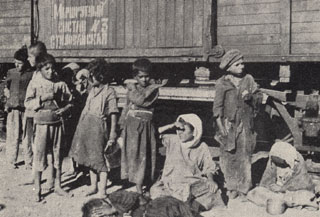 |
 |
| Story of Near East Relief (1915-1930) An Interpretation
by James L. Barton 1930
| |
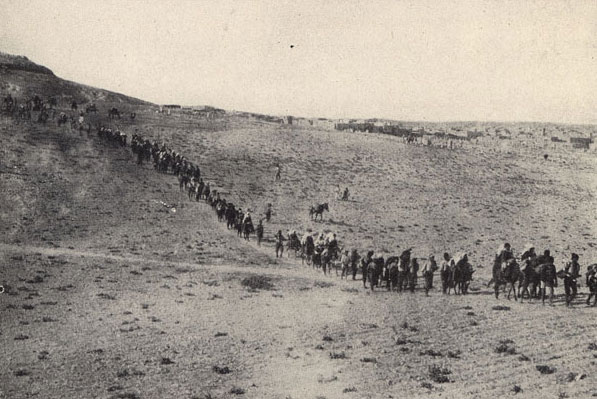 |
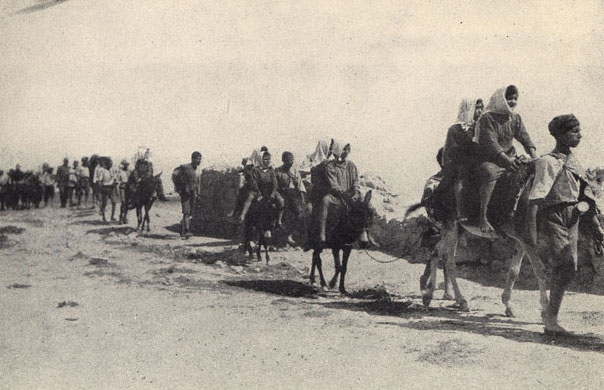 |
| Story of Near East Relief (1915-1930) An Interpretation
by James L. Barton 1930 "In 1922-23 Near East Relief evacuated 22,000 children from ophanages in interior Turkey to Syria and Greece. These two pictures show part of the 5,000 children from Karput en route on donkey back and foot" |
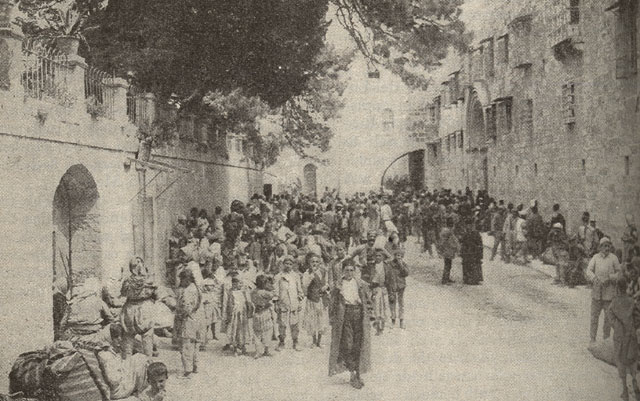 |
| Collection of Maggie Land Blanck |
American Review of Reviews July December 1918
Armenian refugees quartered temporarily on Mount Zion, at St James Monastery-Transported later to the Great Refugee Camp at Port Said. |
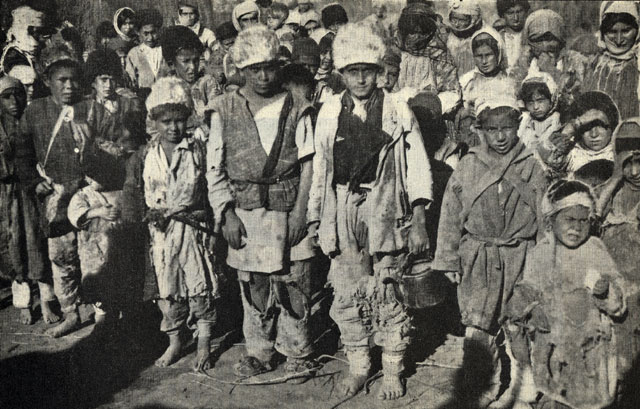 |
| Collection of Maggie Land Blanck |
WAITING FOR AMERICA FOODThis photo was taken from a 1920 Review article by Major-General James G Harbord, the Head of the American Mission to Turkey and the Near East. By that time there were hardly any adult Armenians still living in Turkey. There were large orphanages full of many hungry children such as those pictured above. |
| If you have any suggestions, corrections, information, copies of documents, or photos that you would like to share with this page, please contact me at maggie@maggieblanck.com |
|
RETURN TO TOP OF PAGE |
|
Please feel free to link to this web page. You may use images on this web page provided that you give proper acknowledgement to this web page and include the same acknowledgments that I have made to the provenance of the image. Please be judicious. Please don't use all the images. You may quote up to seventy five words of my original text from this web page and use any cited quotes on this web page provided you give proper acknowledgement to this web page and include the same acknowledgments that I have made to the provenance of the information. Please do not cut and paste the whole page. You may NOT make use any of the images or information on this web page for your personal profit. You may NOT claim any content of this web page as your original idea. Thanks, Maggie |
| © Maggie Land Blanck - Page created 2004 - Latest update, July 2013 |